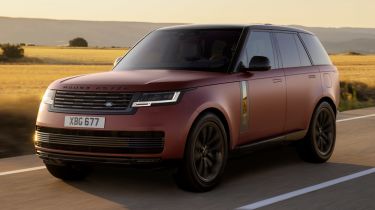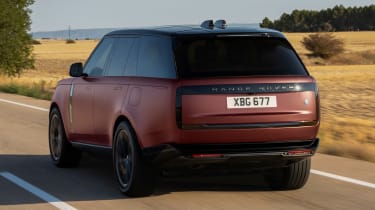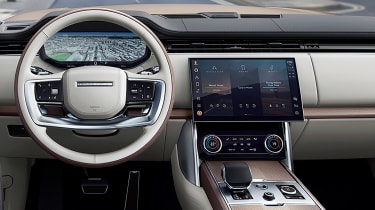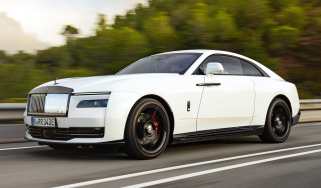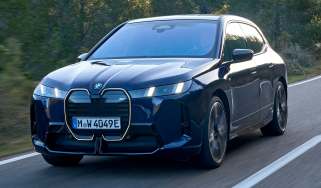New Range Rover PHEV 2022 review
Is the new plug-in hybrid Range Rover P510e the best version yet of the new luxury SUV? We find out…

Verdict
This plug-in hybrid model is the most relaxing Range Rover yet. Adding a significant dollop of electric torque to boost refinement further still, making the P510e serene on the move. The ride is (mostly) great and it handles surprisingly well for such a big machine. Ultimately, a car like this is meant to deliver unrivalled luxury, and this plug-in version climbs to higher heights than any model so far.
Land Rover will go the whole hog next year and unveil a fully electric Range Rover, beating the likes of Bentley to market with a luxury EV, but for many this might not quite cover all of the bases a car as competent as the new Range Rover needs to, so as a transition technology before the brand turns fully EV the Range Rover plug-in hybrid will spearhead the assault for now.
It comes in two flavours, P440e and P510e, the numerical figure denoting the total combined power output of its petrol-electric set-up. Both use the same 3.0-litre turbocharged straight-six petrol engine, with the former offering a total of 434bhp and 620Nm of torque. Land Rover's engineers have turned up the ICE component's potency for the latter, with a total system output of 503bhp and 700Nm of torque.
Both cars use the same 38.2kWh battery and 141bhp electric motor, with the all-electric range for this P510e SV model standing at 68 miles. There's an EV driving mode, while Hybrid is the default setting; the Range Rover even uses geofencing tech so it can save battery power to ensure electric propulsion is available in low emissions zones. This can be done manually, too, by using the Save setting, deploying energy later on in a journey when it's needed.
Used - available now

2025 Land Rover
Range Rover
22,124 milesAutomaticDiesel3.0L
Cash £79,490
2021 Land Rover
Range Rover
59,148 milesAutomaticDiesel3.0L
Cash £48,991
2021 Land Rover
Range Rover
46,898 milesAutomaticPetrol3.0L
Cash £49,995
2020 Land Rover
Range Rover
78,823 milesAutomaticDiesel4.4L
Cash £33,900It's the more potent P510e we're trying here, and as you'd expect, with plenty of near-silent all-electric running, refinement is superb. The Range Rover glides along serenely on battery power and offers enough performance despite its bulk.
Throttle pick-up is linear and the big SUV delivers enough acceleration in EV mode to mix it with city traffic, where the car feels big but more socially acceptable thanks to its powertrain. Visibility is good and it's actually easy to manoeuvre thanks to standard all-wheel steering that means this five-metre-long car has a turning circle as tight as a supermini's.
Despite the chassis having to deal with the plug-in hybrid car's extra mass, and on 22-inch wheels, the Range Rover's ride is still supreme, offering cushioning from bumps in conjunction with surprisingly good body control. At lower speeds the wheels still do thud slightly over grids and potholes, but it's far from intrusive. On the move it feels like the suspension filters out all of the nasty feedback and vibrations you don't want, so you're removed from the mechanical systems working away underneath you to just the right degree.
Yet it's still good to drive. On the twistier Spanish roads of our test route the car's tech combined to deliver a surprisingly rewarding driving experience for a big, luxury SUV. The steering is light and precise, and with active roll control, rear-wheel steering and adaptive air suspension the Range Rover PHEV serves up agility and comfort in just the right split, weighted towards the latter.
It's a nicely judged package that's matched by the powertrain. The electric motor's punch helps fill in for the petrol engine on the exit of junctions and corners, while the in-line six-cylinder unit offers plenty of smooth performance and a sophisticated soundtrack to go with it. Push it to its max and the 0-60mph sprint will take 5.3 seconds.
However, the car feels at its best making the most of the available battery power, whatever situation that might be. On the motorway the Range Rover is keen to run for extended periods – and at higher cruising speeds – in EV mode, while even when the engine is running refinement is superb. In this situation the comfort-focused set-up comes into its own too, offering just the right degree of float to the ride, with body movements well attenuated so as not to cause much in the way of head toss in the cabin.
Inside, it's trimmed with the same mix of luxurious materials and subtle design flourishes as you'll find in the regular model. The cabin layout and features are conventional by modern standards when compared with some EV upstarts such as Tesla, but this breeds familiarity, so combined with the excellent infotainment (Land Rover has made huge strides on this front over recent years) the Range Rover is easy to get to grips with.
The 13.7-inch digital dash is joined by a 13.1-inch central touchscreen running the brand's Pivi Pro system. It's snappy to respond to finger prods and the graphics are good, with Land Rover claiming 90 per cent of tasks are accessible in just two steps from the home menu. The reality is that many owners might just simply connect their smartphone wirelessly and opt to use either Apple CarPlay or Android Auto. Top-spec SV models – available in Intrepid and Serenity themes – feature every bit of kit you could imagine as standard.
When it comes to space inside there's no drawback by adding a relatively big battery, made possible by the latest car's all-new MLA-Flex platform. There's a superb level of legroom in the rear even in Standard Wheelbase form so rear-seat passengers won't be complaining.
Packaging the battery doesn't actually impact boot space, with the standard car's 818-litre offering carried over for the PHEV. This latest generation of the Range Rover also retains its split tailgate, which is electrically operated as standard.
Practicality extends to charging, and the Range Rover P510e is one of few PHEVs on the market that features CCS rapid charging. It can accept a feed of up to 50kW, meaning the battery takes less than an hour to charge to 80 per cent; a full charge using a home wallbox takes five hours.
| Model: | Range Rover P510e |
| Price: | £154,300 |
| Powertrain: | 3.0-litre 6cyl turbo petrol PHEV |
| Power/torque: | 503bhp/700Nm |
| Transmission: | Eight-speed automatic, four-wheel drive |
| 0-60mph: | 5.3 seconds |
| Top speed: | 150mph |
| Economy/CO2: | 318.9mpg/20g/km |
| On sale: | Now |

